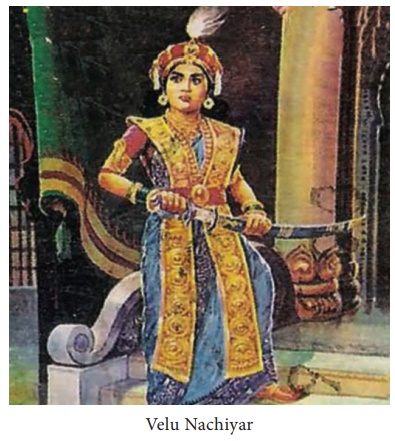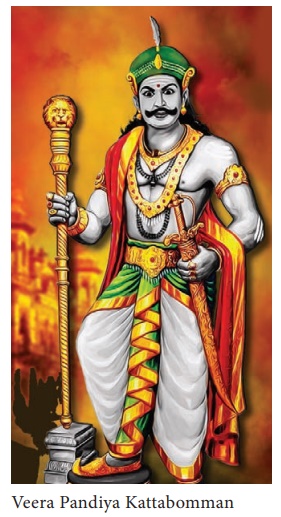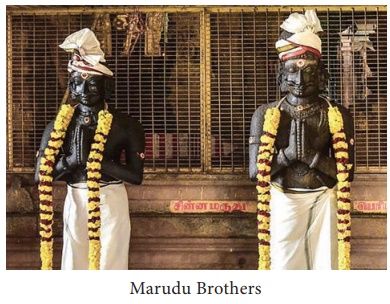Early Resistance to British Rule - Early Resistance of Southern Palayakkarars against the British | 11th History : Chapter 18 : Early Resistance to British Rule
Chapter: 11th History : Chapter 18 : Early Resistance to British Rule
Early Resistance of Southern Palayakkarars against the British
Early Resistance of Southern
Palayakkarars against the British
Origin of Palayams and Palayakkarars
After the decline of Vijayanagara Empire, Nagama
Nayak who arrived as a viceroy to Madurai and his son Viswanatha Nayak asserted
themselves as independent rulers of Madurai and Tirunelveli. Under the able
guidance of prime minister Ariyanayaga Mudaliyar, all the little kingdoms of
the former Pandian Empire were classified and converted into 72 palayams.
Viswanatha Nayak constructed a formidable fort around Madurai city, which
consisted of seventy two bastions. Each of them was placed under a chief.
A Palayakkarar was bound to pay a fixed annual
tribute or supply troops to the king and to keep order and peace over a
particular area. In order to enable him to perform these duties and attend to
other services, a certain number of villages were granted for revenue
collection. In addition he was presented with several titles and privileges.
Palayakkarars had judicial powers and dispensed justice over civil and criminal
cases.
The origin of the Palayakkarar
(poligari) system dates back to the 1530s. It is believed that this system was
practiced earlier in Kakatiya kingdom of Warangal. The literal meaning of
Palayakkarar is the holder of a camp as well as the holder of an estate on
military tenure. Prior to the enforcement of this system Servaikarars and
Talayaris collected fees for police work. After the creation of palayams, the
Servaikarars turned Palayakkarars and subordinated Talayaris to their
authority.
Based on the topographical distribution they are
classified as western palayams and eastern palayams. The palayams held by
Maravar chieftains were mostly in the western parts of Tirunelveli. The
settlement of Telugu migrants in the black soil tracts, lying in the eastern part
of Tirunelveli, left those parts under Nayak Palayakkarars.
Revolt of Palyakkarars
The Nawab of Arcot, who had borrowed heavily by
pledging the villages in several parts of Tamilnadu, entrusted the task of
collecting land revenue arrears to the Company administration. Yusuf Khan,
remembered as Khan Sahib, had been employed as commander of the Company’s
Indian troops. He was entrusted not only with the command of the forces, but
also with the collection of revenue. At the request of the Nawab, a force of
500 Europeans and 200 sepoys was (1755), ordered to proceed into the “countries
of Madurai and Tirunelveli” to assist him. The encroachment of East Indian
Company administration into palayakkarar’s authority aroused stiff resistance.
Mafuzkhan (Arcot Nawab’s elder brother) was
appointed by the Nawab as his representative in those territories.
Mafuskhan along with Colonel Heron proceeded
towards Tirunelveli. They easily took Madurai. An expedition was sent to reduce
Kattabomman, the palayakkarar of Panchalamkurichi but had to be recalled. While
returning Colonel Heron was urged to storm the fort of Nel-Kattum-Seval. Its
palayakkarar Puli Thevar wielded enormous influence over the western
palayakkarars. For want of cannon and of supplies and pay to soldiers, the
attack of Colonel Heron had to be abandoned and the force retired to Madurai.
Three Pathan officers, Nawab Chanda Sahib’s agents,
named Mianah, Mudimiah and Nabikhan Kattak, commanded the Madurai and
Tirunelveli regions. They supported Tamil palayakkarars against Arcot Nawab
Mohamed Ali. Puli Thevar had established close relationships with them. The
palayakkarars of Uthumalai, Surandai, Thalaivankottai, Naduvakurichi,
Singampatti, Urkad, Seithur, Kollamkondan and Wadakarai joined Puli Thevar’s
confederacy. With the promise of restoring Kalakkadu, Puli Thevar had already
won over the ruler of Tranvancore to his confederacy.
Nawab, on his side, sent an additional contingent
of sepoys to Mahfuzkhan and the reinforced army proceeded to Tirunelveli.
Besides the 1000 sepoys of the Company, Mahfuzkhan received 600 more sent by
the Nawab. He also had the support of cavalry and foot soldiers from the
Carnatic. Before Mafuskhan could station his troops near Kalakadu, 2000
soldiers from Travancore joined the forces of Puli Thevar. In the battle of
Kalakadu, Mahfuzkhan's troops were trounced.
The organized resistance of the palayakkarars under
Puli Thevar gave an opportunity to the British to interfere directly in the
affairs of Tirunelveli.
Yusuf Khan was born as Maruthanayakam
Pillai. Originally he belonged to Ramanathapuram district. When in Pondicherry
he embraced Islam. He joined the company of sepoys under Clive in 1752 and
participated in the siege of Tiruchirappalli during 1752-54. From 1756 to 1761
he was in charge of the districts of Madurai and Tirunelveli as Governor under
the Madras Government which had been controlling them though they belonged to
the Nawab of Arcot. He defeated Haider Ali and captured Solavandan. At the time
Lally’s siege of Madras (1758-59), he rendered splendid service to the English.
As one in charge of administration of Madurai and Tirunelveli regions he
encouraged the weaving industry of Madurai. He gave a fixed amount for the
conduct of worship in the temples of Madurai and retrieved the temple lands.
Yusuf Khan rebelled because the English ordered him to serve the Nawab of
Arcot.
From 1756 to 1763, aided frequently by Travancore,
the palyakkarars of Tirunelveli led by Puli Thevar were in a constant state of
rebellion against the authority of the Nawab. Yusuf Khan who had been sent by
the Company would not venture to attack Puli Thevar unless the big guns and
ammunition from Tiruchirappalli arrived. As the English were involved in a war
with the French, as well as with Haider Ali and Marathas, big guns arrived only
in September 1760. Yusuf Khan began to batter the Nerkattumseval fort and this
attack continued for about two months. On 16 May 1761 Puli Thevar’s three major
forts namely Nerkattumseval, Vasudevanallur and Panayur came under the control
of Yusuf Khan. After taking Pondicherry the English commanded respect, as they
had eliminated the French from the picture.
Consequently the unity of palyakkarars began to
break up as French support was not forthcoming. Travancore, Seithur, Uthumalai
and Surandai switched their loyalty. Yusuf Khan, who was negotiating with the
palayakkarars without informing the Company administration, was charged with
treachery and hanged in 1764.
Puli Thevar, who had taken asylum elsewhere after
the forts were taken over by Yusuf Khan, returned and began to organize against
the British. Captain Campbell who was sent this time by the British, laid siege
and captured Nerkattumseval in 1767. Nothing is definitely known about the last
days of Puli Thevar.
Velu Nachiyar

The Sethupathys ruled the area that covered
Ramanathapuram, Sivagangai, Virudhunagar, and Pudukkottai districts of the
present day. Velu Nachiyar was the daughter of Chellamuthu Sethupathy, the raja
of Ramanathapuram. She married Muthu Vadugar Periyaudayar, the Raja of
Sivagangai, and had a daughter named Vellachi Nachiar. When her husband was
killed by the Nawab’s forces, Velu Nachiyar escaped with her daughter and lived
under the protection of Haider Ali at Virupachi near Dindigul for eight years.
During this period she organized an army and succeeded in securing an alliance
with Gopala Nayaker and Haider Ali. In 1780 Rani Velu Nachiyar fought the
British with military assistance from Gopala Nayaker and Haider Ali and won the
battle.
Velu Nachiyar employed her
intelligence gathering agents to discover where the British stored their
ammunition. One of her followers Kuyili, doused herself in oil, set herself
alight, and walked into the storehouse. She also employed another agent, her
adopted daughter Udaiyaal, to detonate a British arsenal, blowing herself up
along with the barracks. Velu Nachiyar formed a woman’s army.
The Nawab of Arcot placed many obstacles to the
advancement of the Rani’s troops. However she overcame all the hurdles and
entered Sivagangai. The Nawab of Arcot was defeated and taken captive. Velu
Nachiyar recaptured Sivagangai and was again crowned queen with the help of
Marudu brothers.
After ascending the throne Velu Nachiar appointed
Chinna Marudu as her adviser and Periya Marudu as commander. In 1783 the
English forces invaded Sivaganagai again. This time the Marudu Pandiyan saved
the place by some diplomatic moves. In 1790, Vellachi Nachiyar, daughter of
Velu Nachiyar who was married to Vengan Periya Udaya Thevar who became the king
of Sivagangai state due to compromise formula of the Englishmen, died under
mysterious circumstances. Velu Nachiyar became sick and died in three years
later in1796.
Veera Pandiya Kattabomman

While Velu Nachiyar was fighting the British and
engaging their complete attention on Ramanathapruam and Sivagangai, Veera
Pandiya Kattabomman’s resistance against the British was on progress.
Kattabomma Nayak was the playakkarar of Panchalamkurichi. Kattabomman Nayak was
a family title. The chieftain of the Colonel Heron’s time was Jagaveera
Kattabomman Nayak, the grandfather of Veera Pandiya Kattabomman. This Veera
Pandiya Kattabomman, born in 1761, became the palayakkarar on the death of his
father, Jagaveera Pandiya Kattabomman. The collection of tribute continued to
be a problem as there was a constant tussle between the Company and the
southern palayakkarars. In September 1798 as the tribute from Panchalamkuriuchi
fell into arrears, Collector Jackson wrote to Veera Pandiyan in his
characteristic arrogance.
Pagoda was the dominant currency in
use at the time of arrival of European traders. It was a gold coin of
Vijayanagar descent. It was called varagan in Tamil. During the reign of Tipu
Sultan, one pagoda was the equivalent of three and half rupees in Mysore.
“Shaking the pagoda tree” was a phrase used in England to describe the
opportunities for making quick fortunes in India.
The country experienced a severe drought, in
consequence of which the palayakkarars found it difficult to collect taxes. Collector Jackson wanted to send an
expedition to punish Veera Pandiyan but the Madras administration did not
agree. The Company had already withdrawn its forces from Tirunelveli to be
employed in the war against Tipu Sultan of Mysore, and did not desire to risk a
conflict in the far south at this juncture. It directed the collector to summon
the Palayakkarar at Ramanathapuram and hold a discussion. Accordingly, on the
18 August 1798 Jackson despatched an order directing Veera Pandiyan to meet him
at Ramanathapuram within two weeks. After sending the summons, the collector
started on a tour of Tirunelveli. When Jackson halted at Chokkampatti,
Sivagiri, Sattur and Srivilliputhur to receive tribute from the Palayakkarars,
Veera Pandiyan sought an interview but was told that he could meet the
collector only at Ramanathapuram.
Despite this humiliation, Kattabomman followed the
Englishman for twenty three days over 400 miles through the latter’s route and
reached Ramanathapuram on 19 September. An interview was granted the same day
and the collector expressed his satisfaction that the Palayakkarar had behaved
properly and thereby “saved himself from ruin”. Upon a verification of accounts
Jackson was convinced that Kattabomman had cleared most of the arrears, leaving
only 1080 pagodas as balance to be settled.
Denied of courtesy, the palayakkarar and his
minister Sivasubramania Pillai had to stand before the arrogant collector.
Finally he directed them to stay inside the Ramanathapuram fort. Now a few
sepoys appeared, apparently to arrest Kattabomman. But they escaped. At the
gate of the fort a clash occurred, in which some including Lieutenant Clarke
were killed. Siva subramania Pilai was taken prisoner but Kattabomman made his
escape.
After his return to Panchalamkurichi, Kattabomman
wrote to the Madras Council blaming the attitude of Jackson for the scuffle. In
the meantime Governor Edward Clive had issued a proclamation, inviting the
palayakkarar to submit to the authority of the Company. In the event of
surrender he assured a fair investigation into the Ramanathapuram incident. If
he refused, he threatened Kattabomman with dire consequences. In response
Kattabomman appeared before the committee which acquitted him of the charges of
rebellion and condemned the conduct of the collector. S.R. Lushington was
appointed collector in the place of Jackson, who was eventually dismissed from
service.
However, Kattabomman remained irreconciled. At this
time Marudu Pandiyan of Sivaganga along with Gopala Nayak of Dindigul and Yadul
Nayak of Anamalai, was engaged in organising a Confederacy against the British.
In view of the identity of interests Kattabomman and Marudu Pandiyan came
closer.
Kattabomman also established contact with the
Sivagiri palayakkarar. While Panchalamkurichi was situated in an open plain and
appeared vulnerable, the strategic location of the fort of Sivagiri at the foot
of the Western Ghats and the formidable barriers around it rendered it
eminently suited both for offensive and defensive operations.
Thus in a bold attempt to strengthen his position
an armed column consisting of the followers of Veera Pandiyan, the son of the
Palayakkarar of Sivagiri and other allied chiefs, led by Dalawai Kumaraswami
Nayak, moved towards the west. As the Palayakkarar of Sivagiri was a tributary
to the Company, the Madras Governor’s Council considered this as a challenge to
its own authority and ordered the march of the army.
In May 1799 Lord Wellesley issued orders from for
the advance of forces from Trichirapalli, Thanjavur and Madurai to Tirunelveli.
The Travancore troops joined the British. Major Bannerman, armed with extensive
powers, effectively commanded the expedition.
On 1 June 1799 Kattabomman, attended by 500 men,
proceeded to Sivaganga. At Palayanur Kattabomman held deliberations with
Marudu. Subsequently, joined by 500 armed men of Sivaganga, Kattabomman
returned to Panjalamkurichi.
The Palayakkarars of Nagalapuram, Mannarkottai,
Powalli, Kolarpatti and Chennulgudi had already formed themselves into a
combination due to the efforts of Marudu brothers. They asserted their rights
to collect taxes from certain villages in the Company’s territory. Kattabomman
proceeded to join this league to take up its leadership by virtue of the influence
that he wielded and the resources he possessed. Determined to strengthen this
league, he persuaded the chieftains of Satur, Yezhayirampannai, Kadalgudi and
Kulathoor to join it.
On 1 September 1799 Major Bannerman served an
ultimatum directing Kattabomman to see him at Palayamkottai. As Kattabomman
dodged Bannerman decided on military action. The Company army reached
Panchalamkurichi on 5 September.
Kattabomman’s fort, 500 feet long and 300 feet
broad, was constructed entirely of mud. The Company forces cut off the
communications of the fort. Kattabomman’s forces fought gallantly and
successive attacks were repulsed. Colonel Welsh recorded in his memoirs the
gallantry of Kattabomman's soldiers. The English ordered for the arrival of
more troops. On 16 September reinforcements arrived from Palayamkottai. As the
broken walls appeared vulnerable, the garrison evacuated and reached Kadalgudi.
In a clash at Kalarpatti, Kattabomman’s minister Sivasubramonia Pillai was
taken prisoner. The British forces followed up their victory with the reduction
of Nagalapuram and other strongholds of the defiant chiefs to submission. On
the appearance of the army the western Palayakkarars too surrendered.
Vijaya Ragunatha Tondaiman, Raja of Pudukottai,
captured Kattabomman from the jungles of Kalapore and handed him over to the
enemy. Upon the fall of the Palayakkarar into the hands of the enemy, his
followers fled to Sivaganga and from there to the hills of Dindigul for taking
service with Marudu Pandiyan and Gopala Nayak.
Bannerman brought the prisoners to an assembly of
the Palayakkarars and after a mockery of trial sentenced them to death. On 16
October Veera Pandiya Kattabomman was tried before an assembly of Palayakkarars
at Kayatar. Unmindful of impending death Kattabomman admitted all the charges
levelled against him. He declared that he did send his armed men against
Sivagiri and that he did fight the British troops in the battle at
Panchalamkurichi. On 17 October Kattabomman was hanged to death at a
conspicuous spot near the old fort of Kayatar. Kattabomman’s heroic exploits
were the subject of many folk ballads which kept his memory alive among the
people.
Marudu Brothers and the South Indian Rebellion of 1801

By the treaty of 1772 the Arcot Nawab had
authorized the Company to collect the Stalam Kaval and Desakaval. This affected
the Kaval chiefs in both the Palayakkarar and non-palaykkarar territories. The
aggrieved kavalkarars and their chiefs had joined the palayakkarars in their
fight against the Nawab and the Company. In Sivagangai, Vella Marudu and Chinna
Marudu, who had taken over the administration from Periya Udaya Tevar, who died
in battle against the Nawab’s forces, expelled the forces of the Nawab and
proclaimed Vellachi, daughter of Periya Udaya Tevar and Velu Nachiyar, as the
queen of Sivagangai. The Marudus assumed the charge of the ministers. The
temple of Kalayarkoil in the heart of the then Sivagangai forest became the
rallying point of the rebels. When Umathurai reached Kamudhi after the
execution of his brother Veera Pandiya Kattabomman, Chinna Marudu took him to
Siruvayal, his capital.
Now, Nawab Mohammad Ali released Muthuramalinga
Thevar from jail and enthroned him as the Setupati of Ramanathapuram. But the
rebels proclaimed Muthu Karuppa Thevar as their ruler. They occupied the
southern and northern regions of the kingdom. The soldiers made their entry
into Madurai too. In July Umathurai led his followers to Palayanad in Madurai
and captured it. In 1801 both the Sivagangai and Ramanathapuram forces joined
together under the command of Shevatha Thambi, the son of Chinna Marudu, and
marched along the coast towards Thanjavur. Thereupon the distressed peasants in
Thanjavur also joined the force of Shevatha Thambi. Captain William Blackburne,
the resident of Thanjaur collected a force and defeated Shevatha Thambi near
Mangudi. Serfoji, the raja of Thanjavur stood firmly by the British. Yet the
fighters could elude the pursuit of the British troops by rapid movements,
while laying the entire region waste.
Related Topics